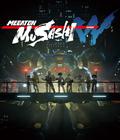There are many indie platformers that have either been highly influenced by or created from fan-made games for Sonic the Hedgehog. It only takes a cursory glance at titles like Spark the Electric Jester or Freedom Planet to see how much inspiration they've taken from the early games starring Sega's 16-bit mascot. Dynacat is another game that feels influenced by the old Sonic games — but not the ones that usually come to mind.
Dynacat already mimics the classics in that the exposition isn't in the cut scenes. In fact, the opening just sees Dynacat looking over a valley full of spikes and then deciding to go into action. The Steam page's description goes into a little bit more detail and states that Dynacat's home is being invaded by robots wanting to steal the energy from the land, forcing the titular hero to fight back to save the land. It isn't the deepest of stories, but you have to admire the old-school approach of pushing aside most of the narrative elements and focusing on the gameplay.
As mentioned earlier, Dynacat takes some inspiration from the Sonic the Hedgehog series, but it borrows from several games in the series and not one in particular. The biggest influence comes from Sonic 3D Blast, Sega's last Sonic game for the Sega Genesis/Mega Drive and one developed by Traveller's Tales. The game is presented with an isometric viewpoint, which provides more dimensions of movement in exchange for a fixed camera angle. The isometric viewpoint can be jarring, but some principles of Sonic carry over in that speed remains paramount. There are multiple pathways to reach the energy pump that needs to be destroyed. While you can go straight for the goal, the multiple pathways are important if you're into secrets, as they all lead to crystals that open up a bonus stage. Worlds are split into three parts, with two of them having you seek out the energy pump while the third has you directly fighting a boss.
The move to an isometric viewpoint can present problems when it comes to attacking foes, but the game has a grapple tool to compensate for that. It looks like a line of sparkly energy, and it immediately reminds you of the tether in Knuckles Chaotix. It acts more like the homing attack in the 3D Sonic games, as you can hit the corresponding button while in the air to automatically hit enemies or other points of interest, like springboards. It also takes a page from Sonic Forces in that you can use it to grab onto poles so you can go around in a circle to change direction without losing momentum. You can also pull back on those poles to launch yourself over large gaps. You can even use the tool to grab some enemy projectiles and fling it back at them; this is an essential skill, as it's the only way to kill some foes.
The grapple tool helps the gameplay, but there are several other things that drag down the overall experience. The first is the decision to mimic the first Sonic game by not including a mechanic similar to the spin dash, where you can hit high speeds almost instantaneously. That may initially seem like a small thing until you realize that the levels are populated with springs that only activate when you're at top speed, and you aren't given enough room to achieve that speed through normal means. You'll also miss it when you realize that you need to climb a hill and have no momentum to do anything but slowly go backward. Unless you perfect the art of moving around at top speed, there will be several areas you can't access throughout your journey.
The problem with trying to reach top speed is that the controls don't help you accomplish it. Part of the issue comes from the fact that at top speed, you're afforded very little control to steer in the right direction, and you'll need to do that often since you'll be off of your intended line — despite the tutorial informing you that everything is handled automatically. Another issue is that when you aren't at top speed, the controls can feel squirrelly. You can never come to a complete stop even if you move only a short distance, and you'll often unintentionally collide with spikes after hitting an enemy or jumping after hitting a boss. It feels less slippery than Sonic 3D Blast but not by much.
The control and level design issues are compounded by the fact that Dynacat doesn't give you much room to make mistakes. You get one free hit before you die, and while the game is gracious enough not to count pits as instant deaths, you can't refill the hit bar until you reach a checkpoint. Despite there being an abundance of orbs to obtain, the game doesn't adopt the standard Sonic mechanic of letting you get hit in exchange for losing all of the orbs, so those collectibles are merely for points.
These elements culminate in a game that punishes players at every opportunity. Speed boosters can often lead to parts where you need quick reflexes to avoid hazards, but the game doesn't give you enough time to react to them, resulting in free hits. Enemy encounters often lead to traps where you have no choice but to get hurt and hope you reach a checkpoint in time. Some boss fights become exercises in frustration due to a combination of not being able to avoid some hazards and not being able to target the boss with your grappling tool — despite it being useful for all other enemies. It gets to the point that the only way you can guarantee any progress is by playing the game at the Easy difficulty level, where you can take infinite hits and not worry about the game design actively working against you. The game knows how to quickly cancel out the notion of fun, and that's a shame for a platformer where the perspective and inspiration present an uphill battle. On a side note, the fact that the first three worlds are heavily inspired by early Sonic games isn't exactly appealing, so it's also disappointing that players have to hit the halfway point before seeing some distinct environments.
Sound-wise, Dynacat is fine but very familiar in some places. The sound effects sound like they came straight from a Sonic the Hedgehog game, with a slight bit of tweaking done to make it barely distinct. The music fares better in that it doesn't seem like a remix of more familiar music, but it also isn't quite so memorable. It's not terrible, but it certainly isn't something you'll be humming along to when it plays.
Graphically, the game feels like a throwback in that it uses the cel-shading technique that was popular in the early 2000s. Everything from the environments to the characters features the look of bold colors bordered by black lines. It isn't as detailed as expected, and some things (such as a blown-up reactor at the end of most levels) possess some blurry textures, but it works fine overall. The frame rate is rock-solid throughout, while the camera is only problematic because of some level designs. For those sporting ultrawide monitors, support is available, and even though the title sequence doesn't look like it conforms to that screen ratio, everything else looks fine in 21:9. The issue is that there's barely any animations. A few enemies have some movement shown for preparing to shoot a gun and firing, but most enemies are so non-distinct that you don't need to show much. Dynacat, on the other hand, only sports animations for their wings fluttering, so movement shows their motionless figure while their body moves. There are no swinging arms or facial reactions, making it feel like a very low-effort affair.
Steam Deck users will find that Dynacat works fine. The game looks clean even on the LCD version of the device, with a locked 60fps on the native 1280x800 resolution. However, the player will need to do some system tweaking, as the game claims to get under three hours of playtime from a full charge. The game also doesn't support cloud saves, which is disappointing if you were hoping to hop between systems.
Your experience with Dynacat is heavily dependent on whether you liked Sonic 3D Blast and the other titles that inspired it. The unwavering camera viewpoint takes some getting used to, but the addition of a tether makes combat more palatable. The rough gameplay mechanics and slippery controls don't make for an enjoyable experience unless you've mastered the physics or set the game to the Easy difficulty level. Unless you're the patient type, you can skip this title until it is deeply discounted.
Score: 5.0/10
More articles about Dynacat











 Save Dynacat's home from the incoming army of robots in this fast-paced 3D platforming adventure. Dash to the goal, find all the secrets and defeat enemies!
Save Dynacat's home from the incoming army of robots in this fast-paced 3D platforming adventure. Dash to the goal, find all the secrets and defeat enemies! 



